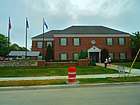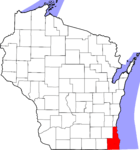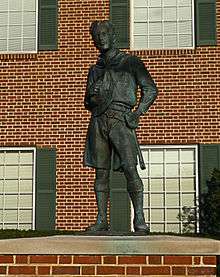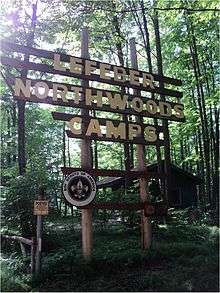Three Harbors Council
Three Harbors Council is a local council of the Boy Scouts of America serving three southeastern Wisconsin counties: Milwaukee County, Racine County, and Kenosha County. Its name and logo refer to the three major port cities of Milwaukee, Racine, and Kenosha (in those three counties of the same name) on Lake Michigan.
| Three Harbors Council (#636) | |||
|---|---|---|---|
 The Walter And Olive Stiemke Scout Service Center | |||
| Owner | Boy Scouts of America | ||
| Headquarters | Milwaukee, Wisconsin | ||
 | |||
| Country | United States | ||
| Founded | 2011 | ||
| Membership | 24,806 (youth)[1] | ||
| Scout Executive | Andrew Hardin[2] | ||
| President | Pat Stiff | ||
| Council Commissioner | Lucia Cronin[3] | ||
|
| |||
| Website www | |||
History
The council was formed from a merger of Southeast Wisconsin Council and Milwaukee County Council in 2011.[4] Southeast Wisconsin Council was itself formed from a merger of the former Racine County Council and Kenosha Council in 1972.[5][6]
| ||||||||||||||||||||||||||||||||||||||||||||||||||||||||||||||||||||||||||||||||||||||||||||||||||||||||||||||||||||||||||||||||||||||||||||||||||||||||||||||||||||||||||||||||||||||||||||||||||||||||||||||||||||||||||||
Districts
The council is subdivided into the following administrative districts:
- The Aurora District serves the northern portion of Milwaukee County (everything north of I-94 plus the west-side suburbs of West Allis and Wauwatosa). (These areas were formerly known as the Polaris, Iron Horse, and Heart of Milwaukee districts.)
- The Southern Shores District serves the southern portion of Milwaukee County (everything south of the Aurora District to the county line). (These areas were formerly known as the Root River and Southshore districts.)
- The Red Arrow District serves Kenosha County and Racine County. (These areas were formerly known as the Fox River, Gateway, and Lighthouse districts.)
- The Scoutreach District overlays all three physical districts with outreach programs.
Service Center

In 1911 Milwaukee established a Scout office on East Mason Street between North Water Street and North Broadway. As Scouting became more popular, a larger office was leased in 1959 at West 37th Street and West Wisconsin Avenue. The need for a new building became apparent as a result of a long-range study completed by community leaders in 1977; after several years of study and planning, the architectural firm of Plunkett Keymar Reginato designed the building. In 1980, an initial gift of $220,000 from Wayne F. Weiss Trust enabled the Council to purchase and begin to develop the property. Other funding came from a variety of sources—-the largest contribution of $500,000 being from Walter and Olive Stiemke. Upon the completion of the building in June 1985, the employees of Gammex Inc. donated a replica of The Ideal Scout.[10] The bronze life-size sculpture of a Scout in uniform is 5 feet 10 inches (1.78 m) high and rests on a brick pedestal. It is a copy of the 1915 original and was cast in 1985.[11]
Camps

Indian Mound Scout Reservation
Indian Mound Scout Reservation (IMR) is named for the Indian mound at the camp in Oconomowoc, Wisconsin, off of Silver Lake. During the summer months, IMR caters primarily to the council's Cub Scouts. IMR hosts several Cub Scout day camps in cooperation with several nearby councils, including Northeast Illinois Council and Potawatomi Area Council. On a year-round basis, Scouts BSA, Cub Scout and Venturing units (and non-Scouting groups) can rent the cabins and other facilities.
The reservation is split into two different camps: Camp Lazynski to the west and Camp Doerr to the east. Camp Lazynski was donated by Walter Lazynski in 1975 and contains 5 lakes named for his wife, Erma, and daughters, Barbara, Jane, Mary and Katherine.[12] The main attractions of the camp include a mine-themed program area, which after a National Order of the Arrow Service Grant Project from Mikano Lodge in 2005, now includes a panning for gold stream named Turtle Creek. The camp also features a castle, a wooden land ship, mini golf course, and a beautiful sand beach at the aquatics area.
Camp Oh-Da-Ko-Ta
Camp Oh-Da-Ko-Ta, located in Burlington, Wisconsin, offers complete year-round facilities for Cub Scout packs, Scouts BSA troops, and Venturing Crews (42.608816°N 88.294639°W). The camp encompasses 185 acres (0.7 km2) of beautiful rolling hills and woodlands including waterfront on Dyer Lake.
After camping at the lake in 1927,[13] 73 acres of farmland were purchased by Kenosha businessman Charles Nash (of Nash Motor Company) and donated to the Kenosha council in 1929. Buildings were constructed in the spring of 1929, and the campground was named Oh-Da-Ko-Ta in a dedication ceremony on July 21, 1929.[14]
Former camps

In the early years of Scouting, troops would often receive permission to set up temporary camps on privately owned land. For example, the early Racine council set up a cabin they called "Wigwam" in the River Bend area above Horlick's Dam (42°45′53.9″N 87°49′33.0″W), which was a popular place for camping by families and local clubs.[15][16] Eventually, councils began buying or renting land to form larger and more permanent camps. This table summarizes the camps that were used over the years by Three Harbors Council and its parent councils. (Details and sources can be found in each subsection below the table.)
| Camp | Began | Ended | Duration (yrs) |
|---|---|---|---|
| Backus | circa 1925 | after 1947 | 23 or more |
| Chickagami | 1916 or 1920 | 1936 | 17 or 21 |
| Chippecotton | 1936 | 1962 | 27 |
| Davidson (1) | 1933 | 1938 | 6 |
| Davidson (2) | before 1956 | before 2011 | unknown |
| Deerhaven | 1951 | 1971 | 21 |
| Freeman | 1947 | before 1956 | unknown |
| Journal (1) | 1922 | 1946 | 25 |
| Journal (2) | 1946 | 1972 | 27 |
| Journal (3) | 1972 | 1997 | 26 |
| Ka-Ha-Gon | 1967 | 1971 | 5 |
| LeFeber | 1930 | 2015 | 86 |
| Lyle | 1962 | 2015 | 54 |
| Oh-Dah-Ko-Tah | 1924 | 1929 | 6 |
LeFeber Northwoods Camps

Three Harbors Council decided in 2015 to close its LeFeber Northwoods Camps, which had served the Boy Scouts of the Milwaukee County Council and then the Three Harbors Council.[17]
The property is located near Laona, Wisconsin on Hardwood Lake (45.510535°N 88.763860°W). The camp had an extensive history as a logging camp prior to its purchase and donation to the council in 1930. It primarily served Boy Scout summer camps and featured an excellent program drawing in campers from Michigan, Illinois, and several councils located in Wisconsin. The property is 1,120 acres (5 km2) of sub-boreal Wisconsin wilderness around Hardwood Lake with a deeply ingrained history in the region's timber industry. The camp was established in 1930 on land formerly owned by several timber companies, nestled in the midst of the Chequamegon-Nicolet National Forest, where Scouts had access to hundreds of miles of hiking, biking, and boating opportunities.
When it was operated by Milwaukee County Council and Three Harbors Council, it offered a wide variety of program features (including archaeology, bike treks, blacksmithing, climbing and rappelling, fly fishing, golf, horseback riding, rifle & shotgun shooting, tomahawk throwing, whitewater rafting, and windsurfing) and merit badges (from archery to woodcarving, nature study to cooking). It used the patrol cooking method.[18]
On December 11, 2015, the camp was sold to James Flannery, who started logging part of the camp.[19] A non-profit organization called The Baden-Powell Northwoods Experience (not affiliated directly with Boy Scouts of America but consisting of many current and former members of BSA)[20] negotiated with the owner and operated the camp under the name "LeFeber Northwoods Camps",[19] to offer four one-week programs for Boy Scouts and Cub Scouts in the summer of 2016.[21]
Robert S. Lyle Scout Reservation
The Robert S. Lyle Scout Reservation was a 640 acres (2.6 km2) wilderness Boy Scout Camp. The reservation, located 25 miles (40 km) northeast of Antigo, Wisconsin, encompassed two lakes, Aninan and Perch, and had the Wolf River running through it (45.409307°N 89.0633413°W). Like LeFeber, Lyle was one of the few Scout camps that used patrol cooking, where food is provided, but the Scouts cook the meals themselves. The camp offered a dining hall option but the vast majority of troops elected to participate in patrol cooking.
Lyle was one of the few Scout camps that ran an open program, meaning Scouts were free to work on merit badges or do activities of their choice during program time. This unique structure helped teach the Scouts time management as they figured out which part of camp they want to experience next.
Journal (Erin)
The Milwaukee Journal originally donated land in 1922 to the former Milwaukee County Council for a Scout camp that was named Camp Journal.[23] This first camp was located on 7.5 acres (0.030 km2) on Watertown Plank Road west of Highway 100 in Wauwatosa (43.0448°N 88.0546°W), which is now part of Underwood Creek Parkway.[24][25][26] However, this site was small and quickly surrounded by development, so the Journal helped the Scouts buy a 45-acre (0.18 km2) plot northwest of North Avenue and Lilly Road in Brookfield (43.0663°N 88.0937°W), moving Camp Journal to this site in 1946.[24][27] Finally in 1972, the camp was moved to its current 300-acre (1.2 km2) site in the town of Erin near Hartland (43.2094°N 88.3763°W).[28] Camp Journal was sold to Quad/Graphics in 1997 and is now known as Camp/Quad.[29][30] Quad/Graphics allows Scout units to use the camp several weekends each year, at which time Scouts refer to it as "Camp Erin".[31] The company established a conservation easement on the land in 2009, so it can never be developed.[32]
Ka-Ha-Gon
Located at 42.7500°N 88.2310°W,[33] Camp Ka-Ha-Gon was purchased by the former Racine Council in 1967.[22] It was sold to a private foundation when the Racine and Kenosha councils merged in 1971, and they sold it to the Racine County park system in 1982.[34] It is now known as Wadewitz Nature Camp[35][36] and is still occasionally used by Scout units looking for a rustic camping experience near home.
Chippecotton
Land for Camp Chippecotton was donated to the former Racine Council in 1936.[22][37] This camp was on the shore of Pleasant Lake (42.7859°N 88.5540°W)[38][39] in Walworth County,[40] across the lake from Girl Scout camps Pottawatomi Hills (42.7822°N 88.5444°W)[41][42] and Juniper Knoll (42.792372°N 88.553093°W).[43] The camp was referred to generically ("the Boy Scout camp at Pleasant Lake") for many years, receiving the name "Chippecotton" (from a Menominee Indian name for the Root River) in a contest in 1953.[44][45][46][47] The camp was sold in 1962,[22] because its 100-Scout capacity was now too small for the council, and the proceeds of the sale were used to develop the recently acquired Camp Lyle.[48]
Deerhaven
The camp was given to the former Kenosha Council in 1951, and it was sold when Racine and Kenosha Councils merged in 1971.[22][49]
Freeman
Camp Freeman was donated to the former Racine Council in 1947[22] by realtor L. L. Freeman on land at the current location of Colonial Park (42.7363°N 87.8179°W).[50] It was still active in 1951, being used by Scouts for events such as picnics, overnight campouts, and leader training;[51][52] however, it must have been sold to Racine soon afterwards, because Colonial Park is listed as one of the city's largest parks in 1956.[53]
Davidson
This camp was operated by the former Milwaukee County Council in the town of Franklin[54] near Puetz Road west of Highway 41.[55] The land that was formerly Camp Arthur Davidson is now the site of Franklin Woods Nature Center (42.8866°N 87.9631°W), owned by the city of Franklin.[56] It was named after one of the founders of Harley-Davidson, who bought the land and donated it to the Boy Scouts.[57] He also donated another camp in 1933, which was sold in 1938 and became Brown Deer Park (43.1593°N 87.9526°W).[58]
Backus
This camp was operated by the former Milwaukee County Council on the shore of Lake Michigan north of Milwaukee.[59] It was near Doctor's Park in Fox Point,[60] south of what is now the Schlitz Audubon Nature Center. The exact location is unknown, although there was an August Backus living nearby at 1820 E Fox Lane.[61] The exact dates of operation are also unknown and available information is contradictory. One troop was known to have used it from 1925–1929 and then planned to move its buildings to somewhere less civilized,[62] but other reports refer to Camp Backus as one of Milwaukee's main camps in 1938[60] and 1947,[59] suggesting there may have been two locations called by the same name.
Chickagami
This camp[63][64] was in operation from approximately 1916[65] or 1920[66] until 1936[67] and owned by the Consumer's Ice Company of Burlington, WI, but operated with their permission by the Racine County Council. This camp was located on Norton's / Rockland Lake in Burlington, where YMCA Camp MacLean[68] is located today.[65][66] In late 1936 Camp Chickagami's buildings were dismantled and moved to the new Camp Chippecotton property on Pleasant Lake.[65][69]
Oh-Dah-Ko-Tah
The Kenosha council rented the McGuire estate on Camp Lake / Center Lake in 1924 and 1925, operating it as "Oh-Dah-Ko-Tah". This land was bought by Henry Barstow in 1926, and the council acquired 30 acres on the southwest shore of lower Camp Lake instead (42.520519°N 88.150212°W).[70] This land was probably sold in 1929, when the name was reused for a larger camp property on Dyer Lake.
Scout Heritage Museum
Located at 330 South 84th Street in Milwaukee, the Scout Heritage Museum seeks to show the history of Scouting in the Milwaukee area and southeastern Wisconsin as well as national Scouting history. Featured in the museum are historical photographs, rare Scouting books, badges, awards, memorabilia from jamborees and camporees, old uniforms and equipment, and author and illustrator W. Ben Hunt's collection of neckerchief slides and artifacts.
Order of the Arrow
Upon its founding, the Three Harbors Council was temporarily served by two lodges:
- Mascoutens Lodge #8 was formed in 1972 when Oh-Da-Ko-Ta Lodge #153 (chartered in 1939) and Chippecotton Lodge #524 (chartered in 1957) were merged as part of the Racine County Council and Kenosha County Council merger that formed Southeast Wisconsin Council.[71][72]
- Mikano Lodge #231 was founded in 1943. Its name means "Turtle" in the Ho Chunk language.[73]
The terms of the Three Harbors Council merger (dated October 1, 2011) specified that the two lodges should determine how best to consolidate within 18 months of the council merger. In 2012, the Lodge Creation Committee was formed of equal numbers of youth from each lodge with limited adult involvement, aside from the lodge's primary advisers. This committee met multiple times leading up to the 2012 summer camp season to decide on the Lodge Executive Committee structure, how the new lodge is going to utilize all four camps, a chapter system for the larger geographic area, the officers and election cycle, etc. The committee solicited lodge name, totem, and patch ideas from the membership through July 1, 2012.
On the morning of July 8, 2012, the youth of the committee decided and voted on the new name and totem. The decision became official at 10:08 am at LeFeber Northwoods Camps. It was announced that the name and totem would be unveiled at the New Lodge Kickoff on October 20, 2012. However, it was not until January 6, 2013, that the Kanwa tho Lodge #636, was unveiled by the youth committee that created it. The Kanwa tho Lodge is named after a subgrouping of the Potawatomi tribe of Indians headquartered in Milwaukee, Wisconsin. Their totem is the panther, as Kanwa tho translates to "Panther Band".[74]
Kanwa tho Lodge is subdivided into three Chapters, each serving one physical district of Three Harbors Council. The Eluwak Chapter serves the Aurora District, the Tèhink Sipu Chapter serves the Southern Shores District, and Wikiak Sabbeleu Chapter serves the Red Arrow District.[75][76]
Kanwa tho Lodge is also divided into groups of committees lead by Vice Chiefs. The Vice Chief of Chapters is a youth in charge of overseeing the 4 chapters, the Vice Chief of Administration is in charge of the Secretary and Financial Officers, as well as the Membership, Communications, Historian, and Recognition chairmen. The Vice Chief of Program is in charge of the Ceremonies & Dance, Activities, SNARE (Section, National, and Regional Events), Inductions, and Training chairmen.[77]
| ||||||||||||||||||||||||||||||||||||||||||||||||||||||||||||||||||||||||||||||||||||||||||||||||||||||||||||||||||||||||
See also
- Scouting in Wisconsin
- Local council camps of the Boy Scouts of America - Wisconsin
External links
References
- 2011 Annual Report, Three Harbors Council
- "Boy Scouts of America, Atlanta Area Council announces four recent leadership promotions". Retrieved January 6, 2017.
- "Executive – Three Harbors Council Key Three". Retrieved July 20, 2020.
- "Scoutheast Wisconsin Council and Milwaukee County Council Approve Consolidation". Archived from the original on April 2, 2012. Retrieved September 8, 2011.
- "Council Guide 2012 Edition, Vol 5" (DOC). Retrieved March 30, 2012.
- "Council Guide 2012 Edition, Vol 6" (DOC). Retrieved March 30, 2012.
- "District Map". Retrieved April 20, 2020.
- "Districts". Archived from the original on February 13, 2012. Retrieved March 10, 2012.
- "Milwaukee County Council – Districts". Archived from the original on September 22, 2012. Retrieved March 10, 2012.
- Buck, Diane M. and Virginia A. Palmer (1995). Outdoor Sculpture in Milwaukee: A Cultural and Historical Guidebook, p. 49. The State Historical Society of Wisconsin, Madison
- "Ideal Boy Scout, (sculpture)". SIRIS. Retrieved August 2, 2011.
- Johnson, Bruce (November 2007), "http://press-files.anu.edu.au/downloads/press/p27481/pdf/ch0910.pdf", Talking and Listening in the Age of Modernity: Essays on the history of sound, ANU Press, doi:10.22459/tlam.11.2007.09, ISBN 9781921313479 External link in
|chapter=(help) - "Burlington Events: 1835-2006". Retrieved February 2, 2016.
- "Burlington Events: 1835-2006". Retrieved February 2, 2016.
- "Racine Post: Celebrating 175 years: Boy Scouts celebrating a century of work". Retrieved February 2, 2016.
- "History of River Bend - River Bend Nature Center". Retrieved February 2, 2016.
- Jones, Meg (July 12, 2015). "Northwoods Boy Scout camps head into a poignant sunset". Milwaukee Journal-Sentinel. Laona. Retrieved October 13, 2015.
- "2015 LeFeber Northwoods Camps Leaders Guide" (PDF). Archived from the original (PDF) on February 14, 2015. Retrieved February 2, 2016.
- "2016 Camp Update — BPNE". Retrieved February 2, 2016.
- "Board of Directors — BPNE". Retrieved February 2, 2016.
- "Former Staffer returning with his boys to LNC in 2016 — BPNE". Retrieved February 2, 2016.
- "ScoutingTimeline". Retrieved April 5, 2012.
- "Camp Journal Given to Boys". Milwaukee Journal. August 8, 1923. p. 13. Retrieved April 6, 2012.
- "Scouts Dedicate Camp Journal". Milwaukee Journal. September 18, 1972. Retrieved April 6, 2012.
- "Camp is the Answer for These Children". Milwaukee Journal. July 23, 1957. Retrieved April 11, 2012.
- "Plan Day Camp for the Retarded". Milwaukee Journal. June 11, 1956. Retrieved April 11, 2012.
- "Camp Journal Shifts, Grows". Milwaukee Journal. May 5, 1946. Retrieved April 11, 2012.
- "Thunder, Rain Join Camp Dedication". Milwaukee Journal. September 18, 1972. Retrieved April 6, 2012.
- "Tall Pines Conservancy newsletter" (PDF). Spring 2009. Retrieved March 14, 2012.
- "Quad/Graphics Pledges to Preserve Camp Journal". Milwaukee Journal Sentinel. July 31, 1997. Retrieved April 6, 2012.
- "Camp/Erin" (PDF). Retrieved April 5, 2012.
- Don Behm (June 6, 2009). "Biologists take stock of nature at Camp/Quad". Milwaukee Journal Sentinel. Retrieved April 5, 2012.
- "Wadewitz map" (PDF). Retrieved April 5, 2012.
- Jim Kneiszel (December 16, 1996). "Nature's Way". Journal Times. Retrieved April 5, 2012.
- "May Roundtable – A Camping We Will Go! – Fox River District". Retrieved March 14, 2012.
- "Racine County – Camping". Retrieved April 5, 2012.
- "Scout Engineer Commends Racine on New Campsite". Racine Journal Times. June 3, 1936. p. 4. Retrieved April 6, 2012.
- "Image : 100 years of Scouting: Boy Scouts of America celebrates centennial – canoe". Retrieved March 14, 2012.
- "Scout Camporee to Make History". Racine Journal Times. September 11, 1953. p. 4. Retrieved April 6, 2012.
- "Image : 100 years of Scouting: Boy Scouts of America celebrates centennial – old". Retrieved March 30, 2012.
- "Winter's Dream...Summer's Reality...for Racine County Boy Scouts". Racine Journal Times. July 16, 1948. p. 20. Retrieved April 6, 2012.
- "Camp Pottawatomie Hills Facilities and Fees". Retrieved March 30, 2012.
- Mike Hemmingsen; Heidi Bunk (March 5, 2009), Pleasant Lake (Walworth County, Wisconsin) Integrated Sensitive Area Report (PDF), Wisconsin Department of Natural Resources – Surface Water Integrated Monitoring System, p. 7, retrieved April 9, 2012
- "Happenings in the City". Racine Journal Times. April 1, 1953. p. 4. Retrieved April 6, 2012.
- "Scouts Pick a Name with Symbolic Meaning". Racine Journal Times. May 11, 1953. p. 18. Retrieved April 6, 2012.
- "Racine Scout Camp Named Chippicotton". Racine Journal Times. May 7, 1953. p. 6. Retrieved April 6, 2012.
- "Happenings in the City". Racine Journal Times. July 1, 1953. p. 4. Retrieved April 6, 2012.
- "Scouts to Get New Campsite". Racine Journal Times. July 8, 1962. pp. 1–2. Retrieved April 6, 2012.
- "SE Wisconsin Council History". Retrieved April 5, 2012.
- "Overnight Camp Near Racine Made Available to Boy Scouts". Racine Journal Times. January 24, 1947. p. 5. Retrieved April 5, 2012.
- "Day Camps in Full Swing Keep Youngsters Busy". Racine Journal Times. July 19, 1949. p. 8. Retrieved April 6, 2012.
- "Scouters Plan Training Class". Racine Journal Times. June 15, 1951. p. 4. Retrieved April 6, 2012.
- "Hundreds of Acres in Racine's Park System Get a Real Workout in Summer Months". Racine Journal Times. November 11, 1956. p. 40. Retrieved April 6, 2012.
- "$17,500 Gift to Boy Scouts". Milwaukee Journal. April 3, 1956. Retrieved April 6, 2012.
- "2,000 Scouts Plan to Camp". Milwaukee Journal. June 13, 1957. Retrieved April 11, 2012.
- "City of Franklin Comprehensive Outdoor Recreation Plan: 2025" (PDF). April 4, 2011. Chapter 4 page 22. Retrieved April 11, 2012.
- Davidson, Jean (2001). Growing Up Harley-Davidson. Stillwater, MN: Voyageur Press. p. 132. ISBN 0-89658-569-7. Retrieved April 11, 2012.
camp arthur davidson.
- "Services for Davidsons Tuesday". Milwaukee Sentinel. December 31, 1950. Retrieved April 11, 2012.
- "Youth Camps Draw Crowd". Milwaukee Journal. July 6, 1947. Retrieved April 6, 2012.
- "Week End Camp Outing for Group of Boy Scouts". Milwaukee Journal. September 2, 1938. p. 4. Retrieved April 6, 2012.
- "1940 United States Census". Retrieved February 2, 2016.
- "Summer Camp Queries Flood Scout Official". Milwaukee Sentinel. April 6, 1930. Retrieved February 2, 2016.
- "Burlington Events 1835-2006". Retrieved May 28, 2015.
- "Celebrating 175 years: Boy Scouts celebrating a century of work". Retrieved May 28, 2015.
- "Bulletin". Racine Journal-Times. July 8, 1962. Retrieved May 28, 2015.
- "Burlington Events 1835-2006". Retrieved May 28, 2015.
04-08-1926: Consumers Ice Co. granted Racine Boy Scouts privilege of again using company's property at Norton's / Rockland Lake for summer camp. Scouts have used property for past 6 years.
- "Bulletin". Racine Journal-Times. May 3, 1936. Retrieved May 28, 2015.
- "History - YMCA Camp MacLean". Retrieved May 28, 2015.
- "Burlington Events 1835-2006". Retrieved May 29, 2015.
- "Burlington Events 1835-2006". Retrieved February 2, 2016.
- "153". Retrieved March 14, 2012.
- "524". Retrieved March 14, 2012.
- "231 Mikano". Retrieved March 10, 2012.
- "The Prairie Potawatomi". The Wisconsin Archeologist. Wisconsin Archeological Society. 4 (3): 160. 1926. Retrieved January 14, 2013.
- "Bylaw Amendment 2019-01". January 4, 2020. Retrieved April 20, 2020.
- "Lodge Executive Committee Minutes". February 2, 2020. Retrieved April 20, 2020.
- "Kanwa tho Lodge - Home". www.kanwatho.org. Retrieved January 28, 2019.